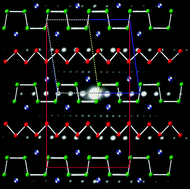On the structures of the rare-earth metal germanides from the series REAl1−xGe3 (RE = Nd, Sm, Gd, Tb, Dy, Ho; 0.6 < x < 0.9). A tale of vacancies at the Al sites and the concomitant structural modulations†
Abstract
A series of ternary rare-earth metal aluminum germanides with the general formula REAl1−xGe3 (RE = Nd, Sm, Gd, Tb, Dy, and Ho; 0.6 < x < 0.9) have been synthesized by direct fusion of the corresponding elements. Their structures have been characterized by single-crystal X-ray diffraction and selected area electron diffraction methods. The average structure for all members is a representative of the orthorhombic SmNiGe3-type structure (Pearson symbol oS20, space group Cmmm), where the Al atoms occupy the Ni site, and the deep off-stoichiometry is due to statistical vacancies at this position. Considering long-range ordering of the vacancies, a monoclinic and a different orthorhombic structure, which represent idealized ordered variants, are possible, and the structural evolution depending on the nature of the rare-earth metals and the amount of vacancies at the aluminum site are discussed. Commensurate and incommensurate structural modulations based on these parent structures are also observed by electron diffraction, attesting to the great structural complexity in these systems. Magnetic susceptibility measurements are presented and discussed, along with the results from electronic band-structure calculations.



 Please wait while we load your content...
Please wait while we load your content...